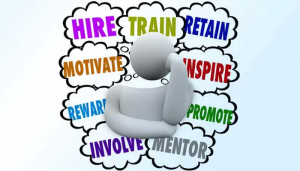The Role Of Confidence In The Workplace
 According to a survey by the job site Indeed, 94% of employees said that confidence is vital to complete daily tasks at work and believe it’s a major contributor to overall career growth. In addition, 98% of those surveyed said they perform better when they feel more confident. These numbers aren’t exactly surprising, but they do highlight the importance that self-confidence plays in the workplace. As we mentioned in our last article, the good news is that confidence isn’t something you’re born with, but something we can all build, practice and reinforce!
According to a survey by the job site Indeed, 94% of employees said that confidence is vital to complete daily tasks at work and believe it’s a major contributor to overall career growth. In addition, 98% of those surveyed said they perform better when they feel more confident. These numbers aren’t exactly surprising, but they do highlight the importance that self-confidence plays in the workplace. As we mentioned in our last article, the good news is that confidence isn’t something you’re born with, but something we can all build, practice and reinforce!
We all want to feel confident at work, but often, it feels like there are forces beyond our control. Maybe you’re new to a job or career path and are terrified of making mistakes. Perhaps you feel like you’re underqualified in a leadership role and don’t have what it takes to build a successful team. Or maybe you’ve always been really hard on yourself and constantly question whether you have what it takes to succeed. Whatever the case, these self-defeating thoughts aren’t doing you any favors and can hold you back from promotions, management roles and more. Self-confidence in the workplace has so many positives, including better communication skills, increased ability to handle feedback and conflict, greater happiness and a decrease in comparing yourself to others.
So, what does confidence in the workplace look like? Not everyone expresses self-confidence in the same way, but there are some common traits that confident people possess. Here’s a few:
- They don’t seek validation from others
- They don’t worry about things outside of their control
- They aren’t afraid to ask for help
- They’re decisive and assertive
- They recognize when they make a mistake
- Their verbal cues match their non-verbal cues (they’re genuine and sincere!)
- They appear confident through their eye contact, dress, body language, etc.
How many do you see in yourself?
Think of the times you’ve let self-doubt seep into your mind. Remember the worry, the sleepless nights, the doubts that you really deserve that promotion you’ve been working for. If you feel like your lack of self-confidence is holding you back in your career, Leah M Joppy and Associates is ready to help you squash those self-defeating patterns. We’ll work together to look at your goals and aspirations, where self-confidence plays a role, what’s holding you back and tools that you can use to make positive changes.
Call us at 301-670-0051 or email leah@lmja.com and let’s start the journey towards greater self-confidence together.
Burnout For Organizations
 Burnout. It’s something no one wants to feel and it’s an issue that no organization wants to experience. But increased levels of employee burnout are becoming more common across every industry and not just the ones we think of most, like healthcare and teaching. Many organizations think of burnout as an “individual problem,” solvable by an employee just taking the afternoon off or practicing some breathing techniques. Wrong! It affects your organization at every level and has a negative impact by decreasing morale and increasing turnover.
Burnout. It’s something no one wants to feel and it’s an issue that no organization wants to experience. But increased levels of employee burnout are becoming more common across every industry and not just the ones we think of most, like healthcare and teaching. Many organizations think of burnout as an “individual problem,” solvable by an employee just taking the afternoon off or practicing some breathing techniques. Wrong! It affects your organization at every level and has a negative impact by decreasing morale and increasing turnover.
According to the World Health Organization, burnout is a syndrome resulting from workplace stress that has not been successfully managed. It’s characterized by three dimensions: feelings of energy depletion or exhaustion; increased mental distance from one’s job or feelings or negativism or cynicism related to one’s job; and reduced professional efficacy (World Health Organization, 2019). It’s incredibly costly for organizations. Consider these statistics: according to the American Psychological Association’s 2021 Work and Well-being Survey of nearly 1,500 U.S. workers, 79% of employees had experienced work-related stress in the month before the survey. Nearly 3 in 5 employees reported negative impacts of work-related stress, including lack of interest, motivation, or energy (26%) and lack of effort at work (19%). Meanwhile, 36% reported cognitive weariness, 32% reported emotional exhaustion, and 44% reported physical fatigue—a 38% increase since 2019.
It’s important to train managers to recognize the signs of burnout in team members and have a comprehensive plan in place to address underlying issues. Symptoms of burnout include:
- Decreased engagement and enthusiasm in work
- Increased absenteeism
- Decreased productivity
- Isolation
- Higher sensitivity to feedback
Employee burnout is one the most pressing challenges that organizations face today. Leaders need to know the prominent signs (as we outlined above) and how to work with team members on solutions that have a lasting impact. It’s no small task, but in the end, it’s a win-win for everyone. Leah M Joppy and Associates is ready to help your organization face any workforce burnout issues head-on before they become major problems. Call us at 301-670-0051 or email leah@lmja.com and let’s discuss your needs.
Ideas for Improving Psychological Safety
 Imagine a work environment where every team member feels comfortable sharing their opinions and ideas.
Imagine a work environment where every team member feels comfortable sharing their opinions and ideas.
- An environment where people feel like they can learn from their mistakes and not humiliated.
- An environment where disagreements and open discussions are encouraged and not seen as a threat.
Perhaps you already work in an office like this and you probably feel grateful for it! However, if you’re like many, it could feel like a dream that will never come true. That’s because many organizations have difficulty developing and maintaining a strong sense of psychological safety for their team members. As we discussed in our last article, psychological safety is about being able to act and engage in a team without fear of negative consequences. It’s one of the strongest proven predictors of team effectiveness.
It takes great leadership and management to create psychological safety. But if you feel like it’s lacking in your organization, what are a few first steps you can take to improve it? Here are some ideas to get started:
- Practice accountability and lead by example: Leaders set the tone for an organization and are responsible for the psychological safety of the workplace. Leaders should be approachable, be open to opinions that differ from their own and be willing to acknowledge their own mistakes (just to name a few).
- Enhance communication skills: For example, ask team members directly for their thoughts and opinions. Encourage people to share by asking questions. Actively ask quieter individuals for their input. Also, practice active listening by leaving your phone on your desk during meetings and improving eye contact.
- Hone conflict resolution skills: No one likes to deal with conflict, but when you’re leading a team, it’s inevitable. If a team member humiliates or undermines others or prevents team members from speaking up, leaders have to be ready to intervene. Just one or two negative people can really put a damper on overall company culture.
- Foster open conversations with team members: It’s vital to pay attention to how your team operates. Do some people dominate during meetings? Are some more quiet and seem reluctant to participate? Make an effort to enable equal speaking time for everyone. A calm environment and perhaps some ice breakers are just a few ways to put everyone at ease. Team outings or even virtual hangouts can also provide an opportunity for team members to let their guard down and get to know each other better.
Saying you encourage your team to speak up and be candid is one thing, but creating a culture of trust is another. It takes care, consistency and a commitment to learning new behaviors, but the payoff is worth it! Fortunately, you don’t have to do it alone. Leah M. Joppy and Associates is ready to help with fresh ideas and strategies to help you increase psychological safety within your organization. Call us at 301-670-0051 or email us at leah@lmja.com and let’s start 2023 off on a productive note!
Psychological Meaningfulness
 Most of us spend the majority of our week at the office, yet how many of us find our job to be meaningful? It can feel like a pipe dream to find work that makes us feel fulfilled and motivated. And the numbers back this up: according to a study by Bates College and Gallup, over 80% of college-educated Americans aspire to meaningful work, yet less than 50% actually attain it. This isn’t good news for organizations, as a lack of employee engagement and perceived meaninglessness leads to decreased productivity, lower morale and greater turnover
Most of us spend the majority of our week at the office, yet how many of us find our job to be meaningful? It can feel like a pipe dream to find work that makes us feel fulfilled and motivated. And the numbers back this up: according to a study by Bates College and Gallup, over 80% of college-educated Americans aspire to meaningful work, yet less than 50% actually attain it. This isn’t good news for organizations, as a lack of employee engagement and perceived meaninglessness leads to decreased productivity, lower morale and greater turnover
I just recently completed a certification from Cornell University on Diversity, Equity and Inclusion. The course, taught by Professor Nishii, takes a deep dive into the issue of employee engagement and it’s three components. We examined psychological availability last month and this month we’re taking a look at the second component: psychological meaningfulness.
What Is Psychological Meaningfulness?
What do we mean by the term “psychological meaningfulness”? Organizational psychologist William Kahn, author of the 1990 study “Physical Conditions of Personal Engagement and Disengagement at Work”, defined it as “employees perceiving their role/task as meaningful, both to the organization and within the context of wider society, to justify their “full self” being deployed.” Team members feel motivated within their positions due to challenge, opportunities for autonomy and strong goals. They feel like they’re a part of something larger than themselves.
What Psychological Meaningfulness Looks Like – and Steps to Avoid
There is no one-size-fits-all approach to meaningful work. It differs from person to person and often changes as people age, go through periods of personal change and have various life experiences. But we can agree that once a sense of meaningfulness is found, it brings about a greater sense of pride and achievement, a feeling of fulfillment and a satisfaction in finding work that is absorbing and interesting. And while there’s no magic formula for creating meaningful positions, there are definite steps that organizations don’t want to take. Here are 6 of the most common mistakes:
- Failing to recognize and appreciate team members’ contributions
- Creating a disconnect between organization and personal values
- Treating team members unfairly
- Overriding team members’ judgment and making them feel disempowered
- Creating a disconnect between team members
- Putting team members in situations where they feel unsafe
Most organizations don’t know where to begin when it comes to helping their employees find more meaning in their positions and increase overall engagement. The typical “office perks” are often surface level and don’t delve into the root issues. That’s where Leah M Joppy and Associates can help. A fresh approach and perspective, combined with experience tackling all different types of employee disengagement issues is just what you need to start next year off on a positive note! Call us at 301-670-0051 or email us at leah@lmja.com today.
Leading In A VUCA World
 There’s no doubt about it, we’re living in a VUCA world. Although it sounds like something out of a science-fiction movie, VUCA stands for volatility, uncertainty, complexity and ambiguity. And it’s become even more pronounced over the past few years. What’s also becoming clear is that strong management within organizations is more vital than ever and comfortable, classic models of leadership don’t work within our ever-changing climate.
There’s no doubt about it, we’re living in a VUCA world. Although it sounds like something out of a science-fiction movie, VUCA stands for volatility, uncertainty, complexity and ambiguity. And it’s become even more pronounced over the past few years. What’s also becoming clear is that strong management within organizations is more vital than ever and comfortable, classic models of leadership don’t work within our ever-changing climate.
So, what does it take to lead in a VUCA world? It takes a lot of effort, but here are some of the top ways to navigate the waters:
- Developing shared purpose and communicating it effectively: Leaders need to be skilled at building teams that have a shared vision. They must also be adept at helping team members understand their place within the big picture. Communication is key!
- Learning to move out of a comfort zone: The old ways of doing things may have worked in the past, but it doesn’t mean they’re going to work forever. Leaders must be open to change and embrace a fresh and creative approach to tackling challenges.
- Having the confidence to lead through times of uncertainty: Times of change can be difficult to handle and managers feel it as much as their team members (maybe even more!). However, strong leaders must be able to assess available information, risks, etc. and take strong, confident action based on their knowledge.
- Providing consistent support: This includes: mentoring team members to help them adjust to changes, modeling the desired behavior for embracing changes, providing and supporting employee learning and development and acknowledging and celebrating successes!
In today’s constantly changing world, leaders may feel like they need to step up their game to be as effective as possible. However, it can be intimidating
to take the first steps towards meaningful and sustainable action. Leaders don’t have to go it alone. Working with a coach, like Leah M Joppy and Associates, provides managers with a partner that can help them navigate our VUCA world. We work with leaders to develop the competencies outlined above and to survive and thrive in a VUCA climate. We also help leaders develop high levels of resiliency, so they’re ready to take on challenges and are less likely to experience burnout.
Call Leah M Joppy and Associates at 301-670-0051 or email leah@lmja.com to learn how we can help.
A Word For An Unsettled Environment
 Chances are, you’ve probably heard or read the acronym ‘VUCA’ (Volatility, Uncertainty, Complexity, Ambiguity) thrown around a time or two. It’s one of those buzz-worthy terms to describe the unsettled environment organizations have to deal with on a daily basis. And nothing has brought out VUCA more than the past few years, as organizations have dealt with unprecedented changes in day-to-day operations and had to pivot in unexpected ways.
Chances are, you’ve probably heard or read the acronym ‘VUCA’ (Volatility, Uncertainty, Complexity, Ambiguity) thrown around a time or two. It’s one of those buzz-worthy terms to describe the unsettled environment organizations have to deal with on a daily basis. And nothing has brought out VUCA more than the past few years, as organizations have dealt with unprecedented changes in day-to-day operations and had to pivot in unexpected ways.
The acronym ‘VUCA’ was first used in 1987 by the U.S Army War College to describe the unfortunate situation after the Cold War. The term later found its way into the business world and outlines four distinct challenges that leaders face:
Volatility: Challenges are unstable and unexpected. The duration of these challenges is unknown.
Uncertainty: The future is unpredictable. It’s nearly impossible to anticipate events and how they’ll unfold.
Complexity: Information is overwhelming and choosing a single right path is almost impossible. Challenges and their repercussions are more complex and harder to understand.
Ambiguity: Situations are vague and difficult to interpret.
In short, we’re living in a world that’s constantly changing and these changes, whether big or small, are happening faster and faster and in more unpredictable ways. Since we don’t have a crystal ball to see the future, the best way for an organization to be prepared is through strong leadership. As we saw over the past few years, change can be incredibly challenging for team members with people reacting to these changes in different ways. Skilled, prepared leaders are the key to meeting the challenges of VUCA head-on through:
- Maintaining strong lines of communication
- Keeping employees engaged
- Determining fresh and creative approaches to meet changes head-on
- Maintaining and growing productivity
And that’s just the start. It’s a tall order for even the most seasoned leader and one where they’ll need a strong level of support from upper management.
As much as we’d like to make time stand still for a bit and catch our breath, change and the challenges that accompany it, is inevitable. We don’t know exactly what changes are coming down the road, but working with a coach, like Leah M Joppy and Associates, can help your organization be prepared when they do happen. We can take a look at what challenges your organization has faced in the past, how your leadership team handled them, what worked and what didn’t. We can then work with you to improve approaches and develop creative and flexible solutions that will help make this VUCA world we’re living in a little more manageable.
Interested in learning more? Call us at 301-670-0051 or email leah@lmja.com.
Keeping Your Managers In Place
 When it comes to workplace satisfaction, employees continually rate “strong leadership” among one of the most important factors. Your management team is an integral part of your organization, but are you doing everything you can to support them and ensure that they have the necessary tools to lead effectively? In our last article, we looked at a few of the reasons why managers leave their jobs for other opportunities. What can organizations do to reduce turnover among managerial positions and keep current managers engaged? Here’s a look at a few suggestions:
When it comes to workplace satisfaction, employees continually rate “strong leadership” among one of the most important factors. Your management team is an integral part of your organization, but are you doing everything you can to support them and ensure that they have the necessary tools to lead effectively? In our last article, we looked at a few of the reasons why managers leave their jobs for other opportunities. What can organizations do to reduce turnover among managerial positions and keep current managers engaged? Here’s a look at a few suggestions:
- Provide adequate training: Some people are born leaders, but most need training and support when they’re in a managerial role. However, managers are often last in line when it comes to training and development. And it’s one of the biggest mistakes organizations can make. There are all kinds of beneficial training for managers, from honing their soft skills to methods for delegating more effectively and increasing productivity, to name a few.
- Monitor stress: The past few years have been particularly stressful for workers and managers are no exception. They’ve probably been trying to manage the anxiety and stress within their team, but they also need someone in their corner. Regular check-ins, encouraging open and honest feedback and providing flexibility to create work/life balance can really go a long way.
- Give regular feedback and praise: Consistent conversations about performance need to take place at all levels of an organization and that includes managers. Give praise where praise is due and provide constructive feedback on areas that could use improvement. Make sure managers are in the loop about future plans, so they understand where to place their priorities.
- Have regular career conversations: Managers who see opportunities for progression and a career path are more likely to be happy and engaged. If you can show them how their role might develop over time, they will continue to bring enthusiasm to the job.
If it sounds like a lot, don’t worry. That’s where working with a coach, like Leah M Joppy and Associates, can really help. We get to know your organization, your management team and help develop a plan to combat any issues head-on. We can also help develop training programs that tackle a variety of subjects.
Leah M Joppy and Associates is ready to work with your managers to not only increase job satisfaction, but ensure they feel supported in their role. It’s an investment that will pay off in increased loyalty and lower turnover. Call us at 301-670-0051 or email leah@lmja.com to learn how we can help.
Re-focusing On What Matters
 So many of us go through the motions when it comes to our day-to-day work, but the last couple of years truly changed all of that. The way we work, the way we manage, and the way we interact are just a few of the areas that were turned upside down for so many of us. It tested our resilience, our patience and most likely, our mindset. Usually the New Year is a time to hit the reset button with refreshed energy. However, after recent events you and your team are probably feeling burned out and overwhelmed. This can lead to a negative mindset that doesn’t help any department move forward.
So many of us go through the motions when it comes to our day-to-day work, but the last couple of years truly changed all of that. The way we work, the way we manage, and the way we interact are just a few of the areas that were turned upside down for so many of us. It tested our resilience, our patience and most likely, our mindset. Usually the New Year is a time to hit the reset button with refreshed energy. However, after recent events you and your team are probably feeling burned out and overwhelmed. This can lead to a negative mindset that doesn’t help any department move forward.
How can you help your employees start the New Year with a fresh, focused mindset when everyone is still reeling from recent challenges? If there’s one area you should focus on, it’s relationships. Employees need connection, support, and guidance from management and peers in order to feel engaged and valued. Here are a few commitments you can make in the coming months to refocus and improve mindset:
Reconnect with your team. To effectively manage your team, it’s important to understand their values, interests and strengths. Make it a goal this year to get to know them better and develop a plan to have team members connect with each other more effectively going forward.
Make goal creation a shared task. We’ve all dealt with feelings of isolation during the past years, so including team members in the goal creation process makes them feel included, valued, and part of the organization. It gives everyone a chance to reflect on what worked last year, what didn’t, and how to move forward with renewed energy.
Share more performance information. No one wants to feel like they’re being kept in the dark. Team members are much more likely to be engaged and focused when they receive clear feedback. If this is an area that you neglected over the past months, now is the time to start reengaging with team members.
The past years have challenged us all, but if there’s one lesson we can take from all of this, it’s the importance of strong relationships for building a positive team mindset. This year, commit to enhancing employee relationships through observing, listening, and guiding. Leah M. Joppy and Associates is ready to help you start the New Year off strong by offering coaching seminars that focus on developing a productive, postive mindset. For more information, contact us at 301-670-0051 or email leah@lmja.com.
Get The New Year Started Off Right. How to Reach Your Goals in 2022
 “Do you have a New Years resolution?” Once January hits, it’s a common question that strikes fear in the heart of many. The New Year means a fresh start, a clean slate. Yet, so many of us feel like we still haven’t reached our goals from last year, let alone ready to tackle what we want to achieve in 2022.
“Do you have a New Years resolution?” Once January hits, it’s a common question that strikes fear in the heart of many. The New Year means a fresh start, a clean slate. Yet, so many of us feel like we still haven’t reached our goals from last year, let alone ready to tackle what we want to achieve in 2022.
Each year, you start out motivated, enthusiastic and with the best intentions. You’ve identified a goal (or two) and this time, you’re REALLY going to put in the work, see it through, and accomplish your goal once and for all. Then “things” start to get in the way, like time, finances, and life. All those good intentions are replaced with excuses and, before you know it, that goal you set out to achieve seems impossible to accomplish.
How can you make this year different? It’s time to put pen to paper and outline what you hope to achieve. Writing out your goals is a great way to get all those ideas out of your head and into a format where you can break them down, tweak them and provide yourself with some accountability. Here are four key tips to get started:
1) Tackle Scary Thoughts and Acknowledge Your Fears. There’s an acronym for FEAR: False Evidence Appearing Real. Yes, your goal may seem scary and you start to doubt yourself. We’ve all experienced fear, but the key is to outline where your fears lie, what fears are true and what aren’t based in reality. Write down, “what’s the worst that could happen?” And then, “what’s the best that could happen?” When you come up with answers for each, you’ll see that the pros always outweigh the cons.
2) Break Down the Various Steps to Get There. Let’s say you want to save money to take your dream vacation. You break your goal down further and decide to start by saving $1,000 over the next three months. Now, here’s how you can break it down even more to make it actionable, remembering that you don’t have to tackle every task at once:
- Write down how much money you make each month after taxes
- Write down all the places that you spend money over the course of a month or several months
- Look at all the places you spend money and figure out where you can spend less – cut back on daily coffee runs, streaming services and other similar places
- Examine if there are any ways you could earn extra money over the next few months
3) Schedule Time to Work on Tasks. Scheduling each task is a great way to manage your list because you have a plan of when to tackle a little bit of your goal. Maybe it’s 15 minutes in the morning and you set a timer. Or pull out your calendar and write down a designated time. Put aside the “someday I’ll do it” and just accomplish one task. However small it may seem, the act of doing SOMETHING can build confidence and start to put a goal-achieving plan into action.
4) Make a Plan for When Life Gets In the Way. Life can throw you curve balls, but don’t let those challenges derail your goals. There’s power in planning for obstacles in advance. Having a contingency plan prevents frustration and enables you to keep moving forward.
There are so many things that can stop us from making our goals a reality. But with the right tools and mindset in place, we can calm the voices in our head saying we can’t do it and move towards meaningful change. Make 2022 the year that you accomplish your goals with the help of a coach who can listen, advise and help keep you accountable. Leah M. Joppy and Associates is ready to help! Call us at 301-670-0051 or email us at leah@lmja.com and let’s work together to make your goals a reality.
The Difference Between Resolutions and Goals
 The calendar has changed to 2022 and you’ve vowed to make some lofty changes: healthier, more productive, better grip on your finances. The New Year is ripe with promise. All it will take is to make some resolutions. Or maybe some goals. But wait. What exactly is the difference? Turns out, quite a bit.
The calendar has changed to 2022 and you’ve vowed to make some lofty changes: healthier, more productive, better grip on your finances. The New Year is ripe with promise. All it will take is to make some resolutions. Or maybe some goals. But wait. What exactly is the difference? Turns out, quite a bit.
Resolutions are really just a statement of intent. They’re not as powerful as goals, because goals, when set correctly, include a level of accountability and measurement to move you towards a desirable outcome. Let’s looks at few examples:
Resolutions:
- To spend less time online
- To lose weight
- To read more books
- To save money
Now, let’s turn those resolutions into more powerful goals:
- I will check my email three times per day and will reply to everything immediately. I will spend a maximum of 45 minutes a day on social media and will set a timer to keep myself accountable.
- I will keep a food log of everything I consume in a day to see where I can cut back on sugar, processed foods, etc. I will only order take-out or eat in a restaurant one time per week. I will schedule time to exercise 3 times per week.
- I will choose a book to read each month and immediately order it from Amazon or check it out from the library. I will schedule time to read 1 hour per day.
- I will schedule time to review my finances and see where I can cut back on spending. I will only buy my coffee 2 times per week and will schedule time in the morning to make it at home on the other days.
That’s a powerful difference. Setting goals is so much more attainable because they’re part of a journey. You’re setting a path towards reaching a better place in your life.
Thomas Edison said, “Many of life’s failures are people who did not realize how close they were to success when they gave up.” Success is within your reach and with the right coach to help you along your path, there’s no telling what 2022 has in store for you! Leah M. Joppy and Associates can work with you to identify your goals and create a realistic action plan. We’ll also support you through every step of the process by providing accountability and helping you overcome obstacles. Call us at 301-670-0051 or email us at leah@lmja.com and let’s work together to make your goals a reality.